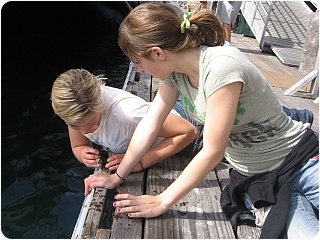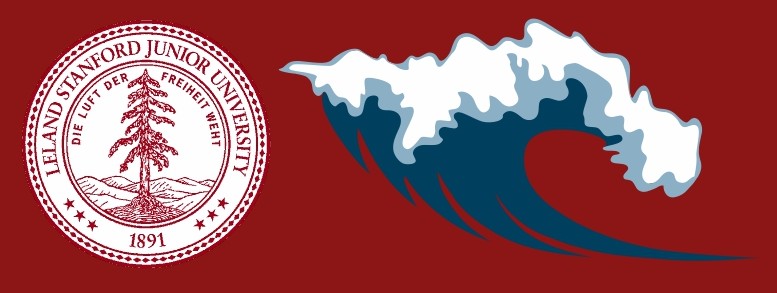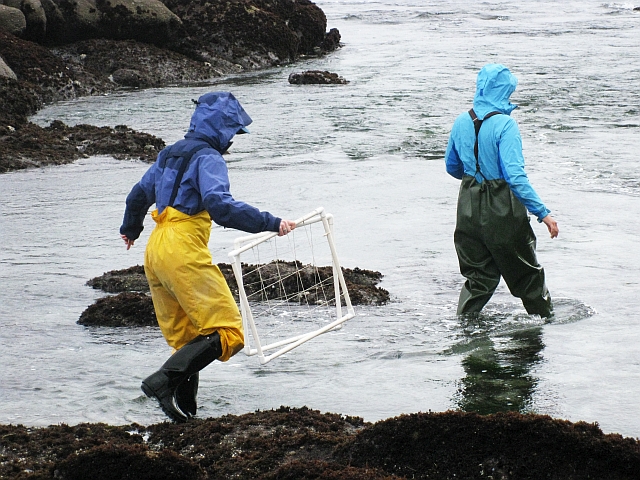Come and indulge your curiosity about the natural world in ways you've never imagined before! With small class sizes and the outside-the-classroom attention provided by it's faculty, Hopkins provides a small liberal arts college experience with the backing of a world premier research university. Be sure to check out the awards many faculty have received for teaching and supporting undergraduate research (see the more link under each faculty member). See Samantha's blog about being here.
Most of the courses at Hopkins have labs or hands-on experiences. Marine Biology is one of six specialized fields of study within the Biology major at Stanford. Hopkins courses fulfill many of the requirements in this track. However, the breadth of Hopkins coursework allows students in other Biology tracks and in other departments (such as Earth Systems, Human Biology, Geology, and even humanities departments) to fulfill major requirements.
Independent research, for which credit is given, is encouraged. Many undergraduates publish work (below) done here during class or a summer internship (below). Research done at Hopkins can be used for an honors project/thesis. You will be able to work one-on-one with professors in a way that is unlike almost anything else you can find at Stanford. This not only complements the in-class learning experience, it also gives you first hand insights into how real science gets done and the potential of science and research as a career.
Learning at Hopkins Marine Station doesn't just happen in the classroom. Check out our offering of field courses where you can spend time sailing the South Pacific, re-visiting sites in Baja and the Sea of Cortez described by John Steinbeck and Ed Ricketts, or diving underwater to study the kelp forests of Monterey Bay.
Internships for Undergraduates
 Faculty accept interns on a case-by-case basis. Undergraduates are highly encouraged to contact faculty directly about summer internships, research projects or honors thesis projects. We encourage contacts early in the school year, because available internships slots tend to fill up fast. Some financial support is available through endowments established for Stanford summer undergraduate internships, through Major Grants at Stanford (deadline March 1), and through faculty research grants. This includes the Research Experiences Especially for Freshmen summer internship program (deadline March 1). The Department of Biology, using funds from the office of the Vice Provost for Undergraduate Education (VPUE), offers paid research internships to current Stanford undergraduates who want to spend the summer participating in ongoing faculty research projects to learn biological research methods (deadline February 1).
Faculty accept interns on a case-by-case basis. Undergraduates are highly encouraged to contact faculty directly about summer internships, research projects or honors thesis projects. We encourage contacts early in the school year, because available internships slots tend to fill up fast. Some financial support is available through endowments established for Stanford summer undergraduate internships, through Major Grants at Stanford (deadline March 1), and through faculty research grants. This includes the Research Experiences Especially for Freshmen summer internship program (deadline March 1). The Department of Biology, using funds from the office of the Vice Provost for Undergraduate Education (VPUE), offers paid research internships to current Stanford undergraduates who want to spend the summer participating in ongoing faculty research projects to learn biological research methods (deadline February 1).
Undergraduates can obtain credits for working in a lab. The faculty occasionally accept local junior and senior high school level students who make arrangements through their schools. High school internships are unpaid. Be sure to read the faculty profiles to see if your interests match up with the type of research that is being done in the laboratories here at Hopkins.
For other possible internships in the Monterey Bay area, you can check on the Monterey Bay Aquarium Research Institute internship program, the Monterey Bay Aquarium internship program, and the volunteer program at the Monterey Bay Aquarium.
Selected Publications
McCauley, D.J., P.A. DeSalles, H.S. Young, Y.P. Papastamatiou, M.H. Deakos, J.P. Gardner, D.W. Garton, J.D. Collen, F. Micheli. 2014. Reliance of mobile species on sensitive habitats: a case study of manta rays (Manta alfredi) and lagoons. Marine Biology161(9): 1987-1998. DOI: 10.1007/s00227-014-2478-7 (DeSalles Winter 2009)
Jorgensen SJ, Arnoldi NS, Estess EE, Chapple TK, Rückert M, et al. (2012) Eating or Meeting? Cluster Analysis Reveals Intricacies of White Shark (Carcharodon carcharias) Migration and Offshore Behavior. PLoS ONE 7(10): e47819. (Arnoldi Spring 2009 & 2011, Estess Spring 2009)
Douglas J. McCauley, Paul A. DeSalles, Hillary S. Young, Robert B. Dunbar, Rodolfo Dirzo, Matthew M. Mills, Fiorenza Micheli. 2012. From wing to wing: the persistence of long ecological interaction chains in less-disturbed ecosystems. Nature, Scientific Reports 2, Article number: 409 (DeSalles Winter 2009)
Papastamatiou YP, DeSalles PA, McCauley DJ 2012. Area-restricted searching by manta rays and their response to spatial scale in lagoon habitats. Marine Ecology Progress Series 456:233-244 (DeSalles Winter 2009)
Jon G. Sanders and Stephen R. Palumbi. 2011. Populations of Symbiodinium muscatinei Show Strong Biogeographic Structuring in the Intertidal Anemone Anthopleura elegantissima. Biological Bulletin. 220(3):199-208. (Sanders Winter/Spring 2005)
Cheryl A. Logan, S. Elizabeth Alter, Alison J. Haupt, Katharine Tomalty, Stephen R. Palumbi. 2008. An impediment to consumer choice: Overfished species are sold as Pacific red snapper. Biological Conservation. 141(6):1591-1599. (Tomalty Winter 2006)
Fiorenza Micheli, Andrew O. Shelton, Seth M. Bushinsky, Alice L. Chiu, Alison J. Haupt, Kimberly W. Heiman, Carrie V. Kappel, Margaret C. Lyncha, Rebecca G. Martone, Robert B. Dunbar and James Watanabe. 2008. Persistence of depleted abalones in marine reserves of central California. Biological Conservation. 141(4):1078-109. (Bushinsky Summer 2005, Spring 2005, Winter 2006, Chiu Winter/Spring 2003)
Charlotte Stevenson, Laure S. Katz, Fiorenza Micheli, Barbara Block, Kimberly W. Heiman, Chris Perle, Kevin Weng, Robert Dunbar and Jan Witting 2007. High apex predator biomass on remote Pacific islands. Coral Reefs. 26(1):47-51 (Stevenson Spring 2002,2003, Summer 2004, Winter 2005, Katz Winter/Spring 2005)
Selected Honors Theses
Guerra, Ana 2013. Ecology of a threatened shorebird in an altered habitat: Bristle-thighed Curlews (Numenius tahitiensis) on Palmyra Atoll. Stanford Digital Repository. http://purl.stanford.edu/sp155kg7383
Markham, Ian 2012. Impacts of within-alga distribution of nitrogen and defense compounds on the consumption of the giant kelp (Macrocystis pyrifera) by brown turban snails
(Chlorostoma brunnea). Stanford Digital Repository. http://purl.stanford.edu/xj391jk5611
Kirkham, Amy 2012. Mesograzers of giant kelp (Macrocystic pyrifera) at Hopkins Marine Station, Pacific Grove, CA: community structure and seasonal patterns. http://purl.stanford.edu/zx025xk3915
DeSalles, Paul Andre 2011. Multiple tools reveal the reliance of mobile species on sensitive habitats: a case study of manta rays (Manta alfredi) and lagoons. http://purl.stanford.edu/jj279fr2561
Bell, Lauren Elizabeth. 2011. Behavioral ecology of the humboldt squid, Dosidicus gigas : insights from an animal-borne video and data logging system. http://searchworks.stanford.edu/view/9160594
Aguilera, Stacy. 2011. A comparison of the SNP variation in the calcification PMCA gene of Lottia gigantea between a Santa Barbara population and a more acidic Monterey Bay population. http://searchworks.stanford.edu/view/9169543
Linsmayer, Lauren. 2011. Physiological Determinants of Invasive Success: Linking Distribution Patterns to Metabolic Physiology in Native and Invasive Blue Mussels (genus Mytilus). http://searchworks.stanford.edu/view/9259498





